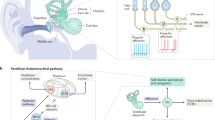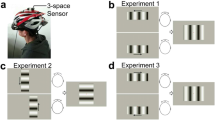Abstract
Recent research highlights the overwhelming role of vestibular information for higher order cognition. Central to body perception, vestibular cues provide information about self-location in space, self-motion versus object motion, and modulate the perception of space. Surprisingly, however, little research has dealt with how vestibular information combines with other senses to orient one’s attention in space. Here we used passive whole body rotations as exogenous (Experiment 1) or endogenous (Experiment 2) attentional cues and studied their effects on orienting visual attention in a classical Posner paradigm. We show that—when employed as an exogenous stimulus—rotation impacts attention orienting only immediately after vestibular stimulation onset. However, when acting as an endogenous stimulus, vestibular stimulation provides a robust benefit to target detection throughout the rotation profile. Our data also demonstrate that vestibular stimulation boosts attentional processing more generally, independent of rotation direction, associated with a general improvement in performance. These data provide evidence for distinct effects of vestibular processing on endogenous and exogenous attention as well as alertness that differ with respect to the temporal dynamics of the motion profile. These data reveal that attentional spatial processing and spatial body perception as manipulated through vestibular stimulation share important brain mechanisms.



Similar content being viewed by others
Notes
It is possible that other cognitive processes in addition to (or instead of) attention account for the results in some of these tasks. Such processes could involve the spatial-numerical association of response codes (SNARC effect) (Hartmann et al. 2012a) and the effect of stimulation on spatial reference frames (Ferrè et al. 2013; Fink et al. 2003).
It should be noted that the Simon effect can be rather transient and disappear after stimulus–response delays exceeding 350 ms (Jong et al. 1994). In our paradigm, however, vestibular stimulation is still present at every cue-to-target delay, so a Simon effect could still occur.
References
Barr DJ, Levy R, Scheepers C, Tily HJ (2013) Random effects structure for confirmatory hypothesis testing: keep it maximal. J Mem Lang 68(3):255–278
Bates D, Maechler M (2010) lme4: linear mixed-effects models using S4 classes. R Package version 0.999375-999335
Berger A, Henik A, Rafal R (2005) Competition between endogenous and exogenous orienting of visual attention. J Exp Psychol Gen 134(2):207
Bottini G, Karnath H-O, Vallar G, Sterzi R, Frith CD, Frackowiak RS, Paulesu E (2001) Cerebral representations for egocentric space functional—anatomical evidence from caloric vestibular stimulation and neck vibration. Brain 124(6):1182–1196
Brown SB, Van Steenbergen H, Kedar T, Nieuwenhuis S (2014) Effects of arousal on cognitive control: empirical tests of the conflict-modulated Hebbian-learning hypothesis. Front Hum Neurosci 8:23
Cappa S, Sterzi R, Vallar G, Bisiach E (1987) Remission of hemineglect and anosognosia during vestibular stimulation. Neuropsychologia 25(5):775–782
Carmona JE, Holland AK, Stratton HJ, Harrison DW (2008) Sympathetic arousal to a vestibular stressor in high and low hostile men. Brain Cogn 66(2):150–155
De Jong R, Liang C-C, Lauber E (1994) Conditional and unconditional automaticity: a dual-process model of effects of spatial stimulus-response correspondence. J Exp Psychol Hum Percept Perform 20(4):731
Ferrè ER, Longo MR, Fiori F, Haggard P (2013) Vestibular modulation of spatial perception. Front Hum Neurosci 7:660
Fiebelkorn IC, Foxe JJ, Butler JS, Mercier MR, Snyder AC, Molholm S (2011) Ready, set, reset: stimulus-locked periodicity in behavioral performance demonstrates the consequences of cross-sensory phase reset. J Neurosci 31(27):9971–9981
Fink GR, Marshall JC, Weiss PH, Stephan T, Grefkes C, Shah NJ, Zilles K, Dieterich M (2003) Performing allocentric visuospatial judgments with induced distortion of the egocentric reference frame: an fMRI study with clinical implications. Neuroimage 20(3):1505–1517
Gale S, Prsa M, Schurger A, Gay A, Paillard A, Herbelin B, Guyot JP, Lopez C, Blanke O (2016) Oscillatory neural responses evoked by natural vestibular stimuli in humans. J Neurophysiol 115(3):1228–1242
Garg M, Lata H, Walia L, Goyal O (2013) Effect of aerobic exercise on auditory and visual reaction times: a prospective study. Indian J Physiol Pharmacol 57(2):138–145
Goldberg JM, Fernández C (2000) The vestibular system. Wiley Online Library, New York
Gray R, Mohebbi R, Tan HZ (2009) The spatial resolution of crossmodal attention: Implications for the design of multimodal interfaces. ACM Trans Appl Percept (TAP) 6(1):4
Green JJ, Woldorff MG (2012) Arrow-elicited cueing effects at short intervals: Rapid attentional orienting or cue-target stimulus conflict? Cognition 122(1):96–101
Halligan P, Marshall J, Wade D (1989) Visuospatial neglect: underlying factors and test sensitivity. Lancet 334(8668):908–911
Hartmann M, Farkas R, Mast FW (2012a) Self-motion perception influences number processing: evidence from a parity task. Cogn Process 13(1):189–192. https://doi.org/10.1007/s10339-012-0484-6
Hartmann M, Grabherr L, Mast FW (2012b) Moving along the mental number line: interactions between whole-body motion and numerical cognition. J Exp Psychol Hum Percept Perform 38(6):1416
Kaliuzhna M, Ferrè ER, Herbelin B, Blanke O, Haggard P (2016) Multisensory effects on somatosensation: a trimodal visuo-vestibular-tactile interaction. Sci Rep 6:26301
Karnath H-O, Dieterich M (2006) Spatial neglect—a vestibular disorder? Brain 129(2):293–305
Karnath H-O, Fetter M, Dichgans J (1996) Ocular exploration of space as a function of neck proprioceptive and vestibular input—observations in normal subjects and patients with spatial neglect after parietal lesions. Exp Brain Res 109(2):333–342
Klein RM (2000) Inhibition of return. Trends Cogn Sci 4(4):138–147
Kliegl R, Wei P, Dambacher M, Yan M, Zhou X (2011) Experimental effects and individual differences in linear mixed models: estimating the relationship between spatial, object, and attraction effects in visual attention. Front Psychol 1:238
Lewald J, Karnath H-O (2000) Vestibular influence on human auditory space perception. J Neurophysiol 84(2):1107–1111
Lewald J, Karnath HO (2001) Sound lateralization during passive whole-body rotation. Eur J Neurosci 13(12):2268–2272
Max C, Widmann A, Kotz SA, Schröger E, Wetzel N (2015) Distraction by emotional sounds: disentangling arousal benefits and orienting costs. Emotion 15(4):428
Oldfield RC (1971) The assessment and analysis of handedness: the Edinburgh inventory. Neuropsychologia 9(1):97–113
Posner MI (1980) Orienting of attention. Q J Exp Psychol 32(1):3–25
Posner MI, Snyder CR, Davidson BJ (1980) Attention and the detection of signals. J Exp Psychol Gen 109(2):160
Poulton EC (1950) Perceptual anticipation and reaction time. Q J Exp Psychol 2(3):99–112. https://doi.org/10.1080/17470215008416582
Prime DJ, McDonald JJ, Green J, Ward LM (2008) When cross-modal spatial attention fails. Can J Exp Psychol/Rev Can Psychol Exp 62(3):192
Proctor RW, Reeve TG (1990) Research on stimulus-response compatibility: toward a comprehensive account. In: Advances in psychology, vol 65. Elsevier, New York, pp 483–494
Prsa M, Gale S, Blanke O (2012) Self-motion leads to mandatory cue fusion across sensory modalities. J Neurophysiol 108(8):2282–2291
Raymond JE, Shapiro KL, Arnell KM (1992) Temporary suppression of visual processing in an RSVP task: an attentional blink? J Exp Psychol Hum Percept Perform 18(3):849
Rorden C, Karnath H-O, Driver J (2001) Do neck-proprioceptive and caloric-vestibular stimulation influence covert visual attention in normals, as they influence visual neglect? Neuropsychologia 39(4):364–375
Santangelo V, Van der Lubbe RH, Belardinelli MO, Postma A (2006) Spatial attention triggered by unimodal, crossmodal, and bimodal exogenous cues: a comparison of reflexive orienting mechanisms. Exp Brain Res 173(1):40–48
Santangelo V, Van der Lubbe RH, Belardinelli MO, Postma A (2008) Multisensory integration affects ERP components elicited by exogenous cues. Exp Brain Res 185(2):269–277
Shuren J, Hartley T, Heilman KM (1998) The effects of rotation on spatial attention. Cogn Behav Neurol 11(2):72–75
Sloan RP, Bagiella E, Shapiro PA, Kuhl JP, Chernikhova D, Berg J, Myers MM (2001) Hostility, gender, and cardiac autonomic control. Psychosom Med 63(3):434–440
Spence C (2010) Crossmodal spatial attention. Ann N Y Acad Sci 1191(1):182–200
Vallar G, Sterzi R, Bottini G, Cappa S, Rusconi ML (1990) Temporary remission of left hemianesthesia after vestibular stimulation. A sensory neglect phenomenon. Cortex 26(1):123–131
van Elk M, Blanke O (2012) Balancing bistable perception during self-motion. Exp Brain Res 222(3):219–228
Watanabe K (2001) Modulation of spatial attention with unidirectional field motion: an implication for the shift of the OKN beating field. Vis Res 41(6):801–814
Acknowledgements
This work has been supported by EU FP7 project VERE WP1, Grant agreement number 257695, the Swiss National Science Foundation and the Bertarelli foundation.
Author information
Authors and Affiliations
Corresponding author
Rights and permissions
About this article
Cite this article
Kaliuzhna, M., Serino, A., Berger, S. et al. Differential effects of vestibular processing on orienting exogenous and endogenous covert visual attention. Exp Brain Res 237, 401–410 (2019). https://doi.org/10.1007/s00221-018-5403-3
Received:
Accepted:
Published:
Issue Date:
DOI: https://doi.org/10.1007/s00221-018-5403-3




